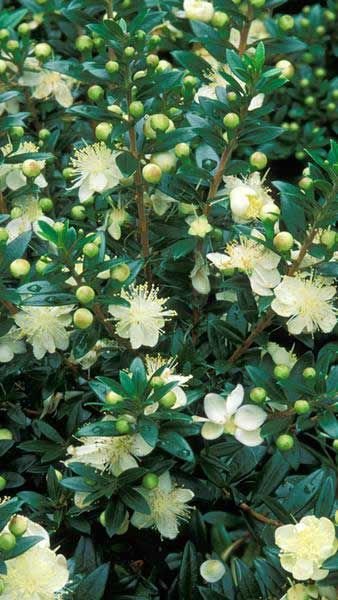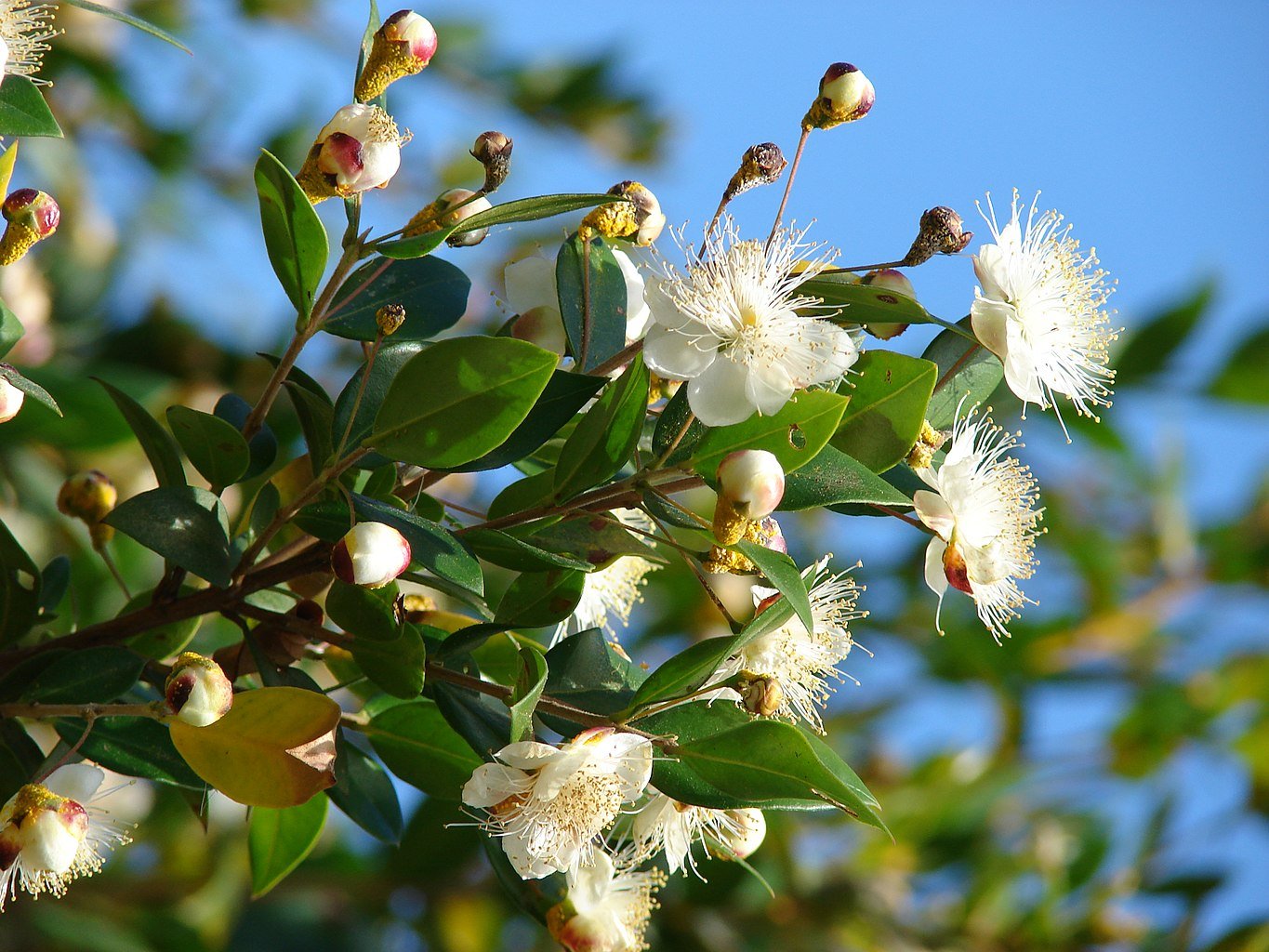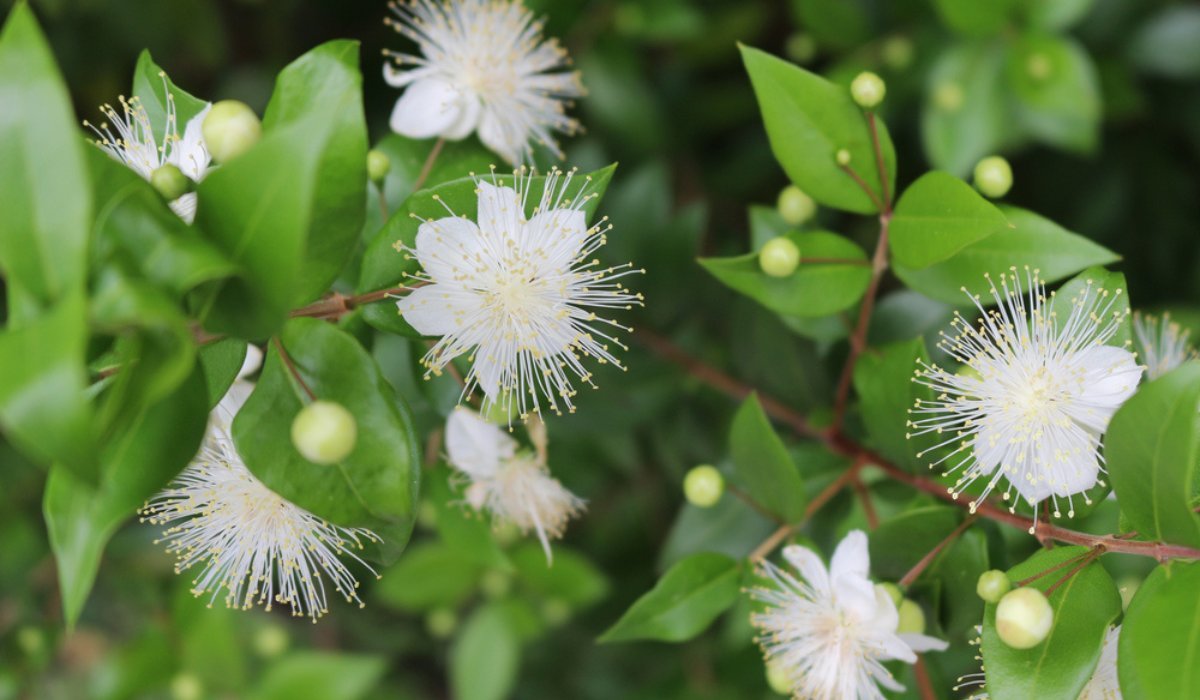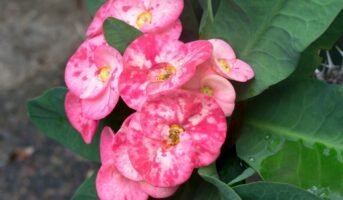The Common Myrtle (Myrtus Communis), native to the Mediterranean and northern Africa, has been a popular houseplant and topiary design element since ancient times. White, fragrant, and delicate, the blossoms were a symbol of purity and love in ancient Greek and Roman culture, and the leaves of Myrtus Communis are highly prized for their medicinal and culinary uses. Read on to learn more about growing and maintaining Myrtus Communis in your garden.

Source: Pinterest
What is Myrtus Communis?
Myrtus Communis is a species of flowering plant belonging to the myrtle family Myrtaceae. This evergreen shrub is renowned for its beautiful white blossoms that can add beauty to any garden. In addition to its ornamental properties, the plant is quite popular for possessing powerful medicinal values.
Myrtus Communis: Common names
Myrtus Communis has a number of other names like true myrtle and common myrtle. It is sometimes also known as Corsican pepper.
Myrtus Communis: Key facts
| Botanical name | Myrtus |
| Family | Myrtaceae |
| Soil | Well-drained |
| Bloom time | Summer |
| Height | 3 to 15ft |
| Sun | Full |
Myrtus Communis: Features
Myrtus Communis has tiny, lanceolate, leathery leaves that are dark green. White flowers of bowl form appear in late summer. Myrtles require a long, hot summer to flower, and then in the fall, they yield tasty, luscious fruits that are similar in size and colour to blueberries but are purple instead of blue. There might be up to 30 seeds in a single fruit.
Myrtus Communis: How to grow Common Myrtle?
To grow new Myrtus Communis plants from seeds or semi-hardwood cuttings, plant seeds beneath a cold frame. Non-flowering shoots should be pruned as new growth becomes firm. The buds must be cut off before the shoot may produce flowers. A 50/50 sand/compost combination should be used for planting, and the area should be kept out of direct sunlight. Six to twelve weeks is needed for rooting. For the winter, bring the Myrtus Communis indoors and pot them in coarse compost. Plant in the ground or in a greenhouse in spring.
See also: Rose flower: 30+ images and over 20 interesting facts about the heavenly flower
Myrtus Communis: Care tips
Myrtus is a versatile plant that may be grown in a variety of settings, including as a solitary ornamental, in a container, as part of a hedge or border, or in a traditional garden setting. Myrtus Communis thrives in urban, coastal, and cottage gardens because of its resistance to drought and wildlife and its low maintenance requirements.
Myrtus Communis: Sunlight requirements
Provide the Myrtus Communis with full to partial sunlight in a west or south-facing place out of the way of the cold, drying wind. It will require a lot of light and air if you intend to grow it as a bonsai indoors. Place outside in the warm summer with partial shade. During the fall, you should move it indoors to a room with temperatures of about 50 degrees Fahrenheit. Put your Myrtus Communis in a south-facing window well or under grow lights.
Myrtus Communis: Soil requirements
Plant a Myrtus Communis in loamy, fertile soil with a lot of water. It does well in either clay or sand, but for the best results, plant it in loam-based compost under fluorescent lights in filtered light and with lots of air circulation.
Soil with a pH greater than 8.3 is very alkaline and can cause iron chlorosis if not treated. If this happens, treatment with elemental sulphur or nitrogen fertiliser will reduce the soil pH.
Myrtus Communis: Water requirements
When the Myrtus Communis is young, it is essential to water the root ball frequently (once a week or more) but not so frequently that it becomes soaked. Although it may survive without water for shorter periods, an older plant does best with deeper watering every two to four weeks.
A Myrtus Communis will not thrive in water that has a high lime content, such as in municipal water supplies. Collecting rainwater for use in watering plants could be beneficial.
Myrtus Communis: Fertiliser Requirements
Outdoor fertilisation should be done once yearly, in the early spring. It is recommended to use a liquid fertiliser once a week during the indoor growth season. You may need to fertilise the Myrtus Communis every two weeks during the winter if it shows any signs of growth at all.

Source: Wikipedia
Myrtus Communis: Pruning requirements
After flowering, prune to shape. To keep Myrtus Communis from getting too big, cut off any dead branches and clean up any infected areas. Hedging plants are pruned with shears to the appropriate height and width.
Unlike regular plants, bonsai and topiary varieties need more frequent early-on trimming. If a new branch has between six and eight leaf pairs, and at least one of those leaf pairs has buds, you should wait to prune it.
Cut some paste and use it to patch up some big cuts. Wire can be used to fix and train young shoots and twigs because it is flexible and not easily broken.
Myrtus Communis: Insects, pests and diseases
The outdoor environment of a Myrtus Communis is often pest-free. An infestation of sucking insects like whiteflies, aphids, and mealybugs, on a small scale, can cause sooty mould, often known as “honeydew,” to form on the plant. In hot, dry conditions, thrips and spider mites could also make an appearance. Indoor bonsai may be vulnerable to pest invasion if kept in a warm, dark, and dry environment.
Myrtus Communis: Uses
When mature, fruit can be eaten straight from the tree, juiced, or turned into a drink; when dried, it can be used as a fragrant spice in savoury Middle Eastern cuisine.
Use Myrtus Communis fruit and flower buds, which have been dried, to flavour sauces and syrups. Sweet aromas and tastes accompany flowers. Some Italians will eat the flower buds fresh from the vine, while others will use them as a garnish.
The plant’s leaves and twigs can be used to produce aromatic oil.
See also: What is Hibiscus and how to grow it in your home?
Myrtus Communis: Medicinal benefits
- Evidence suggests that Myrtus Communis can help eliminate acne and other skin flaws.
- Myrtus Communis is arguably most highly acclaimed for its high quantities of antioxidants, including quercetin, tannins, myricetin, and catechin.
- Antibacterial, antidiarrheal, antiseptic, and astringent qualities have all been attributed to Myrtus Communis.
Myrtus Communis: Is Myrtle poisonous to humans?
Myrtus Communis oil poses serious health risks. A chemical found in it has been linked to asthma episodes and even death from respiratory failure.
FAQs
When should Myrtus Communis be pruned?
It is preferable to prune the Myrtus Communis after blooming.
Can Myrtus Communis be grown indoors?
Yes, but indoor myrtles need lots of light and air.
Housing News Desk is the news desk of leading online real estate portal, Housing.com. Housing News Desk focuses on a variety of topics such as real estate laws, taxes, current news, property trends, home loans, rentals, décor, green homes, home improvement, etc. The main objective of the news desk, is to cover the real estate sector from the perspective of providing information that is useful to the end-user.
Facebook: https://www.facebook.com/housing.com/
Twitter: https://twitter.com/Housing
Email: [email protected]











